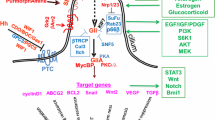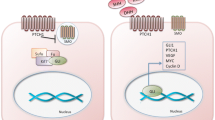Abstract
Hedgehog (Hh) is one of the most important signalling pathways. Together with the Wnt, TGF-β/BMP and Notch pathways, it is involved in both embryonic development and adult tissue homeostasis. This is because Hh plays a central role in the proliferative control and differentiation of both embryonic stem cells and adult stem cells. In this way, an alteration in the Hh pathway, either by misexpression of components of that pathway or by changes in the expression of other cellular components that interfere with the Hh signalling system, may trigger the development of several types of cancer. This occurs because normal stem cells or their intermediaries toward differentiated mature cells are not part of the normal proliferative/differentiation balance and begin to expand without control, triggering the generation of the so-called cancer stem cells. In this review, we will focus on the molecular aspects and the role of Hh signalling in normal tissues and in tumour development.
Similar content being viewed by others
References
Lum L, Beachy PA (2004) The Hedgehog response network: sensors, switches, and routers. Science 304:1755–1759
Gunbin KV, Omelyanchuk LV, Ananko EA (2004) Two gene networks underlying the formation of the anterior-posterior and dorso-ventral wing imaginal disc compartment boundaries in Drosophila melanogaster. In: Kolchanov NA and Hofestaedt R (eds) Proceedings of the Fourth International Conference on Bioinformatics of Genome Regulation and Structure, BGRS’2004. Institute of Cytology and Genetics Press, Vol. 2, pp 56–59
Taipale J, Beachy PA (2001) The Hedgehog and Wnt signalling pathways in cancer. Nature 411:349–354
Taipale J, Cooper MK, Maiti T, Beachy PA (2002) Patched acts catalytically to suppress the activity of Smoothened. Nature 418:892–897
Willert K, Brown JD, Danenberg E et al (2003) Wnt proteins are lipid-modified and can act as stem cell growth factors. Nature 423:448–452
Pepinsky RB, Zeng C, Wen D et al (1998) Identification of a palmitic acid-modified form of human Sonic hedgehog. J Biol Chem 273:14037–14045
Porter JA, Ekker SC, Park WJ et al (1996) Hedgehog patterning activity: role of a lipophilic modification mediated by the carboxy-terminal autoprocessing domain. Cell 86:21–34
Burke R, Nellen D, Bellotto M et al (1999) Dispatched, a novel sterol-sensing domain protein dedicated to the release of cholesterol-modified hedgehog from signalling cells. Cell 99:803–815
Chamoun Z, Mann RK, Nellen D et al (2001) Skinny hedgehog, an acyltransferase required for palmitoylation and activity of the hedgehog signal. Science 293:2080–2084
Zeng X, Goetz JA, Suber LM et al (2001) A freely diffusible form of Sonic hedgehog mediates longrange signalling. Nature 411:716–720
Dann CE, Hsieh JC, Rattner A et al (2001) Insights into Wnt binding and signalling from the structures of two Frizzled cysteine-rich domains. Nature 412:86–90
Taipale J, Chen JK, Cooper MK et al (2000) Effects of oncogenic mutations in Smoothened and Patched can be reversed by cyclopamine. Nature 406:1005–1009
McCarthy RA, Barth JL, Chintalapudi MR et al (2002) Megalin functions as an endocytic sonic hedgehog receptor. J Biol Chem 277:25660–25667
Rahnama F, Toftgard R, Zaphiropoulos PG (2004) Distinct roles of PTCH2 splice variants in Hedgehog signalling. Biochem J 378:325–334
Merchant M, Vajdos FF, Ultsch M et al (2004) Suppressor of fused regulates Gli activity through a dual binding mechanism. Mol Cell Biol 24:8627–8641
Paces-Fessy M, Boucher D, Petit E et al (2004) The negative regulator of Gli, Suppressor of fused (Sufu), interacts with SAP18, Galectin3 and other nuclear proteins. Biochem J 378:353–362
Tay SY, Ingham PW, Roy S (2005) A homologue of the Drosophila kinesin-like protein Costal2 regulates Hedgehog signal transduction in the vertebrate embryo. Development 132:625–634
Wolff C, Roy S, Lewis KE et al (2004) Iguana encodes a novel zinc-finger protein with coiled-coil domains essential for Hedgehog signal transduction in the zebrafish embryo. Genes Dev 18:1565–1576
Eggenschwiler JT, Espinoza E, Anderson KV (2001) Rab23 is an essential negative regulator of the mouse Sonic hedgehog signalling pathway. Nature 412:194–198
Mullor JL, Guerrero I (2000) A gain-of-function mutant of patched dissects different responses to the hedgehog gradient. Dev Biol 228:211–224
Huangfu D, Liu A, Rakeman AS et al (2003) Hedgehog signalling in the mouse requires intraflagellar transport proteins. Nature 426:83–87
Lai K, Kaspar BK, Gage FH, Schaffer DV (2003) Sonic hedgehog regulates adult neural progenitor proliferation in vitro and in vivo. Nat Neurosci 6:21–27
Machold R, Hayashi S, Rutlin M et al (2003) Sonic hedgehog is required for progenitor cell maintenance in telencephalic stem cell niches. Neuron 39:937–950
Palma V, Lim DA, Dahmane N et al (2005) Sonic hedgehog controls stem cell behavior in the postnatal and adult brain. Development 132:335–344
Palma V, Ruiz i Altaba A (2004) Hedgehog-GLI signalling regulates the behavior of cells with stem cell properties in the developing neocortex. Development 131:337–345
van den Brink GR, Bleuming SA, Hardwick JC et al (2004) Indian Hedgehog is an antagonist of Wnt signalling in colonic epithelial cell differentiation. Nat Genet 36:277–282
Mirsky R, Parmantier E, McMahon AP, Jessen KR (1999) Schwann cell-derived desert hedgehog signals nerve sheath formation. Ann N Y Acad Sci 883:196–202
Parmantier E, Lynn B, Lawson D et al (1999) Schwann cell-derived Desert hedgehog controls the development of peripheral nerve sheaths. Neuron 23:713–724
Pola R, Ling LE, Silver M et al (2001) The morphogen Sonic hedgehog is an indirect angiogenic agent upregulating two families of angiogenic growth factors. Nat Med 7:706–711
Duman-Scheel M, Weng L, Xin S, Du W (2002) Hedgehog regulates cell growth and proliferation by inducing Cyclin D and Cyclin E. Nature 417:299–304
Madison BB, Braunstein K, Kuizon E et al (2005) Epithelial hedgehog signals pattern the intestinal crypt-villus axis. Development 132:279–289
Shaw A, Bushman W (2007) Hedgehog signalling in the prostate. J Urol 177:832–838
Hahn H, Wicking C, Zaphiropoulous PG et al (1996) Mutations of the human homolog of Drosophila patched in the nevoid basal cell carcinoma syndrome. Cell 85:841–851
Johnson RL, Rothman AL, Xie J et al (1996) Human homolog of patched, a candidate gene for the basal cell nevus syndrome. Science 272:1668–1671
Dahmane N, Lee J, Robins P et al (1997) Activation of the transcription factor Gli1 and the Sonic hedgehog signalling pathway in skin tumours. Nature 389:876–881
Reifenberger J, Wolter M, Weber RG et al (1998) Missense mutations in SMOH in sporadic basal cell carcinomas of the skin and primitive neuroectodermal tumours of the central nervous system. Cancer Res 58:1798–1803
Unden AB, Zaphiropoulos PG, Bruce K et al (1997) Human patched (PTCH) mRNA is overexpressed consistently in tumour cells of both familial and sporadic basal cell carcinoma. Cancer Res 57:2336–2340
Xie J, Murone M, Luoh SM et al (1998) Activating Smoothened mutations in sporadic basal-cell carcinoma. Nature 391:90–92
Taylor MD, Liu L, Raffel C et al (2002) Mutations in SUFU predispose to medulloblastoma. Nat Genet 31:306–310
Grachtchouk M, Mo R, Yu S et al (2000) Basal cell carcinomas in mice overexpressing Gli2 in skin. Nat Genet 24:216–217
Nilsson M, Unden AB, Krause D et al (2000) Induction of basal cell carcinomas and trichoepitheliomas in mice overexpressing GLI-1. Proc Natl Acad Sci U S A 97:3438–3443
Oro AE, Higgins KM, Hu Z et al (1997) Basal cell carcinomas in mice overexpressing sonic hedgehog. Science 276:817–821
Aszterbaum M, Epstein J, Oro A et al (1999) Ultraviolet and ionizing radiation enhance the growth of BCCs and trichoblastomas in patched heterozygous knockout mice. Nat Med 5:1285–1291
Rubin LL, de Sauvage FJ (2006) Targeting the Hedgehog pathway in cancer. Nat Rev Drug Discov 5:1026–1033
Author information
Authors and Affiliations
Corresponding author
Rights and permissions
About this article
Cite this article
Medina, V., Calvo, M.B., Díaz-Prado, S. et al. Hedgehog signalling as a target in cancer stem cells. Clin Transl Oncol 11, 199–207 (2009). https://doi.org/10.1007/s12094-009-0341-y
Received:
Accepted:
Published:
Issue Date:
DOI: https://doi.org/10.1007/s12094-009-0341-y




